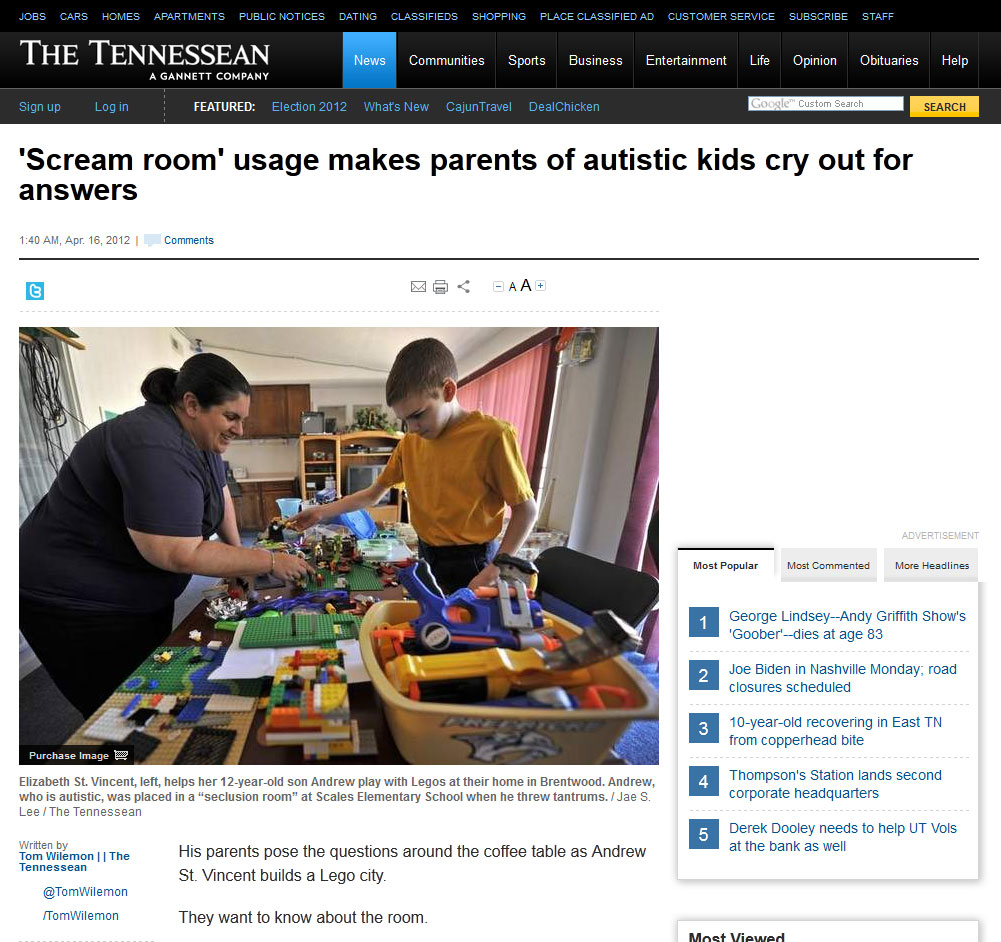‘Scream room’ usage makes parents of autistic kids cry out for answers

His parents pose the questions around the coffee table as Andrew St. Vincent builds a Lego city.
They want to know about the room.
“So you were in there by yourself?” his mother asks.
“When would you be in that room?” his father wants to know.
Michael and Elizabeth St. Vincent have never seen the room. Andrew, their autistic child, told them about it months after they took him out of the Williamson County School District. He went into the room when he threw tantrums, he said.
Teachers put special-education students in “seclusion rooms” when the students exhibit aggression and let them go to “calming rooms” to pre-empt that behavior. The St. Vincents say their son spent too much time isolated in those rooms when he was supposed to have been mainstreamed with other fifth-graders at Scales Elementary School.
Critics call the seclusion spaces “scream rooms.” Autism advocacy organizations are pushing for national legislation to outlaw them or restrict their use.
Tennessee already has set rules for how students can be restrained and isolated. Last year, the state mandated that seclusion rooms had to be at least 40 square feet. The Williamson County School District goes beyond the minimum, requiring theirs to be 100 square feet.
“I believe that this district tries to do what’s right for students,” said Carol Hendlmyer, director of student support services for Williamson County, stressing that teachers seek to follow federal and state guidelines for special-education students and work with their parents to set up individual education plans.
She could not discuss the St. Vincents’ complaints, citing school district privacy policies. Federal law does require that parents of special-needs children be informed about behavior modification plans, she said.
Last autumn, the St. Vincents took their son out of the school district after he did poorly on his Tennessee Comprehensive Assessment Program test even though he had been making A’s and B’s in the sixth grade at Brentwood Middle School.
Andrew, who is almost 13 and now attends a private Christian school, told his mother about going to the room when she was talking about a national news report earlier this year on “scream rooms” in Connecticut.
“I would cry because I was being put in a room and I couldn’t even have my voice heard,” he said.
Holly Lu Conant Rees, who chairs the Disability Coalition in Education for Tennessee, said her organization and others pushed for a state law to set restraint and isolation rules. The legislature passed the initial law in 2009 and revised it last year.
“It is now crystal clear that restraints and isolation are to be used only in emergency situations, regardless of whether or not it is written into a child’s individualized education program,” Conant Rees said.
“And we tightened up the definition of ‘emergency situation.’ Previously, it had pretty subjective language about there being a risk of violence, which I sometimes called the ‘fixin’-to’ clause.”
Calming rooms also used
The state law forbids the rooms from being locked. It also does not allow mechanical or chemical restraints. Specially trained educators are allowed to physically restrain a student to keep him or her or fellow students from harm.
A seclusion room may or may not be padded because that depends upon the needs of a student, Hendlmyer said. The law requires that visual contact with the student be maintained.
“I will tell you not every school has one,” she said. “But when you need one in a school, you need one. Sometimes, the school creates a space that they’ve confiscated. They have checked all the books out and converted it into this room for a specific need. When that need goes away, they convert it back into a storage room again or an office.”
She stressed that very few students ever end up in a seclusion room.
The other separate space provided for special-needs students is a calming room.
“A calming room is used for a very specific purpose,” Hendlmyer said. “It is used in general to prevent a child from being overstimulated or overly aggravated about something so that we try to prevent a serious behavior with a calming room.”
Elizabeth St. Vincent saw her son’s separation when she brought cupcakes to the school on his birthday and he had no classmates with whom to share them. Instead of the classroom, she found him in a smaller, partitioned space with a couple of desks. She thought this was the resource room where he was supposed to go for one-on-one attention for specified subjects. He was playing with a puzzle on the floor.
“Tell you what,” she said to her son. “Why don’t we go over to the lunchroom with everyone else and you can share cupcakes?”
Once all the cupcakes were gone, Andrew went back to his puzzle.
SOURCE: http://www.tennessean.com/article/20120416/NEWS04/304160027/-Scream-room-usage-makes-parents-autistic-kids-cry-out-answers
Originally Published: Apr. 16, 2012
